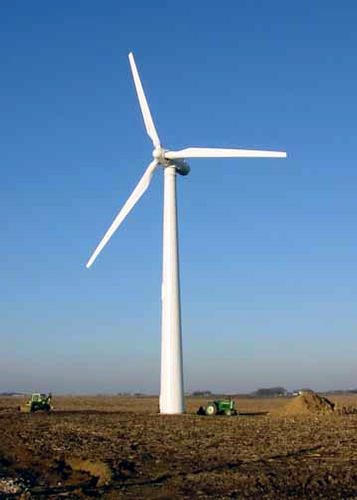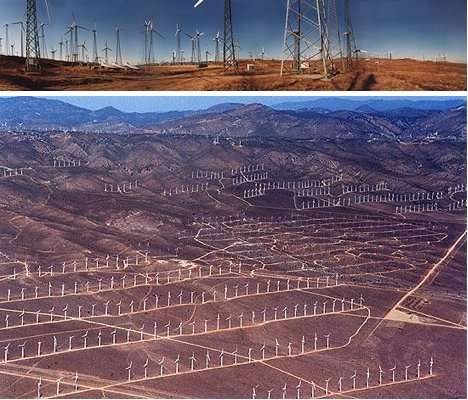The search for alternative forms of energy has led to very interesting technological advancements. One of the best ideas, and also most simple, is capturing the power of the wind. Out of all alternative forms of energy, wind energy is the fastest growing, with an annual growth rate of 30% in the United States. Capturing wind energy is easy, with wind farms being located in different areas across the united states. In fact, a small wind farm out in Wyoming generates enough electricity to power over 9,000 homes! Larger wind farms can produce even more electricity, cutting electricity costs greatly. Although this is a great feat, it’s weird to imagine a slight breeze throughout the day being capable of producing enough power to generate so much electricity. So how do these wind turbines work?
The blades on a wind turbine are turned like an airplane’s blades. This causes air pressure to be uneven, higher on one side and lower on the other. By creating this difference in air pressure, the blade is forced to spin with the wind. The blades are connected to a shaft that only turns around 18 times per minute. This is nowhere near fast enough to generate decent amounts of electricity, so a series of gears are connected to each other inside of the turbine. The final gear is small and rotates about 1800 times per minute (1,000 times that of the initial gear). Because of the high rotation rate, the generator inside the turbine can generate a large amount of electricity. The reason wind turbines are so tall is because winds get increasingly stronger higher off the ground. The taller a turbine, the more efficient it is. Also, the blades on a turbine are around 130 feet long and can sweep a circle in the sky as long as a football field.
Unfortunately, not all areas are feasible for hosting a wind farm. Areas like prairies, deserts, and mountains provide the best locations for harnessing wind energy. Because prairies and deserts are large, wide-open areas, wind can travel freely and is strong enough to produce great amounts of energy. Also, by placing wind turbines on small mountains, the turbines can be powered by stronger winds only found at higher elevations.
Some of the largest wind farms in the United States provide a TON of clean energy. The largest is the Roscoe Wind Farm located in Roscoe, Texas. This wind farm has 627 wind turbines and produces 781.5 megawatts! Altogether the wind farm covers almost 100,000 acres, which is roughly the size of Manhattan. The power produced by the Roscoe Wind Farm provides enough power for 250,000 homes! The second largest wind farm is the Horse Hollow Wind Energy Center, which covers 47,000 acres. It has 421 wind turbines and produces 735.5 megawatts. The third largest is the Tehachapi Pass Wind Farm, which is one of the oldest wind farms in the country. It has both the modern three-blade wind turbines plus older two-blade designs. It produces a total of 705 megawatts.
Wind energy is truly a fascinating form of clean energy. It is simple in design, and requires very little maintenance. Once installed, wind turbines produce energy completely on their own. While not all areas can hold wind farms, there are still plenty of prairies, deserts, and mountains across the world that can be utilized. Besides that, the only other drawback is not all areas can host wind farms due to space constraints. Despite these drawbacks, wind energy is still a great source of clean energy that powers thousands of homes across the United States.
Sources:
1. http://energy.gov/energysaver/articles/small-wind-electric-systems
2. http://www.pcitraining.edu/blog/top-five-largest-wind-farms/
3. http://www.blm.gov/wo/st/en/prog/energy/wind_energy.print.html




I think wind energy seems like one of the better and more feasible renewable energy sources. While it might not be usable everywhere, since you need a lot of room for windfarms, definitely places such as the midwest can utilize this source of energy. I’ve heard of a lot of small problems cropping up, like frequent maintenance which makes the cost not so great and weirdly even birds flying into them as being problematic. But with a little more development, this sounds like a great idea.
Wind technology has begun to develop even further with new designs. I know for a fact honeywell is testing a circular design. Instead of having the blades turn a point in the center, the blades are the generator themselves. Imagine a circle going around the blades. The tips of the blades then produce the electricity instead of being hooked to a generator. Without fully explaining how a generator works it is extremely difficult to describe. So you can get a basic idea of what it looks like here is a link (i just quick googled it for a picture) http://www.yourrenewable-energies.com/honeywell-wind-turbine-6500/technical-specifications
The way these wind farms look reminds me of something from Dr. Suesse, or however you spell his name haha. I like the concept of wind energy, literally no emissons and its obviously very renewable. However, they arn’t practice for for every location, like you said. Also I feel like a wind farm the size of Manhattan should be able to power more than 250,000 homes, not sure why but it makes me wonder if there are ways to make these even more efficent?
I keep forgetting from time to time how large these windmills are. You seem them from a distance and can’t judge them until a propeller part goes by you on the highway. Then once you grasp the size it’s still surprising to see that the wind is strong enough to turn it. It sounds like wind energy is a great prospect, although I heard there was a good amount of maintenance with the technology, especially in winter with ice and anything else that can throw off the balance.
I really like the idea of wind farms. They are completely clean and produce a lot of energy, I never realized how much until I read this. I feel like there is still plenty of space to put wind farms, especially in the Midwest, and that they could be utilized more often. From reading this, I can’t really see all that many reasons not to use them more often, especially when I compare them to the alternate energy sources that I have blogged about.